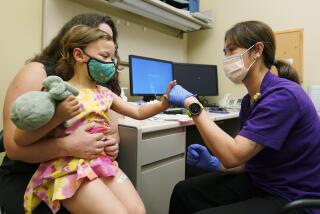Children Point Out Hospital’s Shortcomings
- Share via
Jason Oburgh thinks there ought to be a closed-circuit TV monitor for every bed at Miller Children’s Hospital. That way, the 14-year-old reasons, bed-bound invalids can keep tabs on their nurses even while the nurses are dawdling in the halls.
Jill Gemeinhardt, 10, does not understand why physicians put their hospitalized patients through the ordeal of being discharged shortly after surgery only to insist on seeing them again the next day.
And Cindy Hackworth, 19, is sick and tired of doctors who won’t talk directly to their under-age charges. “What’s really irritating,” she said, “is when the doctor talks to your parents and not to you. A kid needs to know what’s going on.”
An innovative 1 1/2-year-old program at the hospital--which is part of Memorial Medical Center of Long Beach--is aimed in part at helping administrators find out what’s going on. It is called the Children’s Advisory Board. But its most important function, organizers say, is to provide staffers with a kid’s-eye view of hospital life, a potentially frightening experience that has already undergone some important changes as a result of the input.
“It’s a sounding board for the children to express their needs and wants to some of the people who have the power to make changes,” said Susan Perry, director of the 180-bed hospital’s Child Life Department.
Added Dr. Harry Orme, hospital vice president who, as its medical director, created the program in 1987: “For the children to have a say about how their health care is to be provided is extremely helpful to them therapeutically.”
Rotating Membership
Meeting quarterly, the board’s rotating membership consists of about 10 former or current patients between the ages of 9 and 19. “We try to pick children who have had lots of experience at the hospital,” Perry said.
That certainly seemed true of the current crop meeting with hospital staffers recently on a patio next to the second-floor children’s playroom.
Oburgh has had 11 operations since 1982 to correct a microscopic fissure in his bronchial wall. Gemeinhardt has been hospitalized 16 times since the age of 3 for treatment of cystic fibrosis. And Hackworth spent three months in the hospital in 1982 for major surgery on a brain tumor that caused enough complications to keep her going back several times a week for the next two years.
But they had not come to discuss their various infirmities. Instead, the young board members seemed resolute in pointing out the hospital’s shortcomings.
“The nurses are slow,” Oburgh complained. “There should be one nurse per patient.”
Added Gemeinhardt: “I think it’s better to talk to the child than to read the chart.”
Although staffers admit that they can’t change everything, they do point with some pride to a handful of improvements they say have resulted directly from the children’s meetings. Developments in the dietary department, for instance, include the use of special carts to keep food warm and the addition of chicken nuggets to the menu.
When board members complained that a public relations video underestimated the pain of a shot by describing it only as a “pinch,” staffers added the word “hard” to the description. And intravenous punctures that had occasionally been performed by inexperienced nurses are now done only by those who at least practiced on a dummy.
Other improvements include the addition of personnel to free nurses to spend more time with their patients; efforts to decrease the time it takes for a nurse to respond to a patient’s call; procedural revisions aimed at speeding up admissions and treatments, and increased attention to matching roommates by age.
Most board members seem to appreciate the effort.
“They really use our information,” said Karrie Sloan, 15, who spent two years in and out of the hospital for treatment of a rare cyst in her common bile duct. “They don’t think we’re a bunch of kids who don’t know what we’re talking about.”
Youngsters Are Experts
There are more direct approaches, of course, to solving such common hospital dilemmas as getting nurses to pay attention to patient calls. During her stay, for instance, Sloan found a “little trick” to get them into her room more quickly.
“If you pinch off your IV tube,” she said, “it causes the machine to beep” signifying a malfunction.
The result?
“They always came within three minutes,” she said. “That was the meanest thing I did, but it got them in there.”
More to Read
Sign up for Essential California
The most important California stories and recommendations in your inbox every morning.
You may occasionally receive promotional content from the Los Angeles Times.










